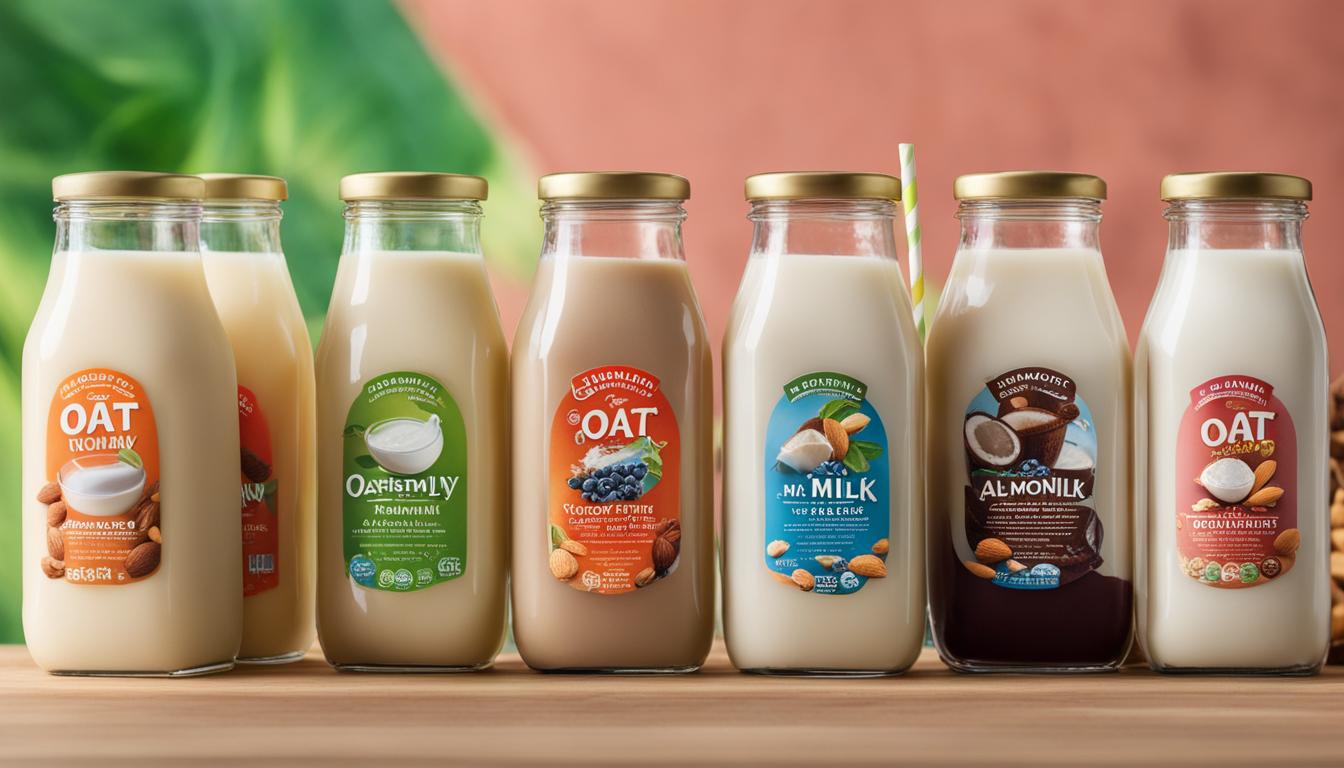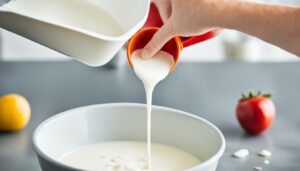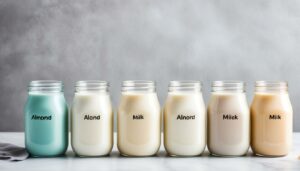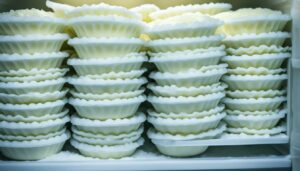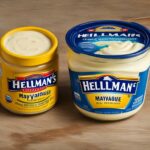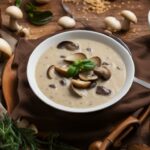When you’re in the middle of a recipe and realize you’ve run out of milk, it can be frustrating. However, there’s no need to panic! There are several dairy-free alternatives and substitutes for milk that you can use in your cooking and baking.
Contents
- 1 Half and Half
- 2 Heavy Cream – A Versatile Milk Substitute in Baking
- 3 Nondairy Milks: Soy Milk and Almond Milk
- 4 Sour Cream
- 5 Yogurt: A Delicious Milk Replacement for Recipes
- 6 Evaporated Milk
- 7 Canned Coconut Milk
- 8 Water: A Limited Option as a Substitute for Milk
- 9 Conclusion
- 10 FAQ
- 10.1 What can be used as a substitute for milk in recipes?
- 10.2 Can half and half be used as a substitute for milk?
- 10.3 How can heavy cream be used as a substitute for milk?
- 10.4 What are some nondairy milk options that can replace milk in recipes?
- 10.5 Can sour cream be used as a substitute for milk in recipes?
- 10.6 Is yogurt a good replacement for milk in recipes?
- 10.7 Can evaporated milk be used as a substitute for milk in recipes?
- 10.8 What about canned coconut milk as a substitute for milk in recipes?
- 10.9 Can water be used as a substitute for milk in recipes?
- 10.10 Are there any other alternatives to milk in recipes?
- 11 Source Links
Key Takeaways:
- Running out of milk in the middle of a recipe can be solved by using substitute options.
- Half and half, heavy cream, and sour cream can be used as one-to-one substitutions for milk in recipes.
- Nondairy milks, such as soy milk and almond milk, are excellent alternatives for those who are lactose intolerant or prefer plant-based options.
- Yogurt, evaporated milk, and canned coconut milk can also be used as substitutes for milk in recipes.
- If you don’t have any of the above options, water can be used as a last resort.
Half and Half
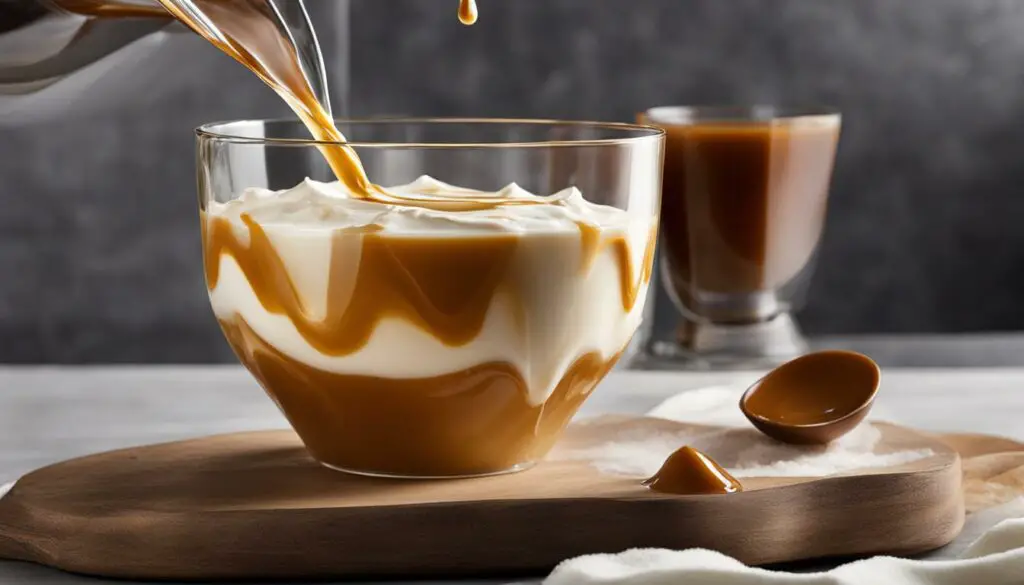
When you find yourself in a pinch and run out of milk in the middle of a recipe, there’s no need to panic. Half and half can come to the rescue as a suitable substitute for milk in many recipes.
Half and half is an equal mixture of whole milk and heavy cream, making it a perfect alternative that provides a similar consistency and flavor. It offers the best of both worlds, delivering the creamy richness of heavy cream without being overly thick like pure cream.
To replace milk with half and half, use a simple one-to-one substitution. For example, if a recipe calls for 1 cup of milk, use 1 cup of half and half instead. This ensures that the liquid ratio remains consistent and the final result is not compromised.
One useful feature of half and half as a milk substitute is its versatility. It can be used in a variety of recipes, including soups, sauces, coffee, tea, and even baking. Its slightly higher fat content enhances the texture and adds a touch of indulgence to your culinary creations.
Here’s a table summarizing the key characteristics and uses of half and half as a milk substitute:
| Characteristics | Uses |
|---|---|
| Equal parts whole milk and heavy cream | – Soups and sauces – Coffee and tea – Baking |
| Provides similar consistency and flavor to milk | – Creamy and rich texture – Enhances the indulgence of recipes |
| One-to-one substitution with milk | – Easy measurement conversion – Maintains recipe integrity |
Heavy Cream – A Versatile Milk Substitute in Baking

When it comes to baking, heavy cream can be a fantastic substitute for milk. With its rich and creamy texture, heavy cream adds decadence and moisture to your baked goods. To use heavy cream as a replacement for milk, it’s important to dilute it with water to achieve the desired consistency.
Here’s a simple guideline for substituting heavy cream in your baking recipes:
- Mix equal parts of heavy cream and water. The recommended ratio is one part heavy cream to one part water.
- Replace the milk in your recipe with the diluted heavy cream. Use a one-to-one substitution.
By following these steps, you can seamlessly incorporate heavy cream into your baking, resulting in delightfully moist and luscious treats.
Nondairy Milks: Soy Milk and Almond Milk

For those who are lactose intolerant or prefer plant-based options, nondairy milks like soy milk and almond milk are excellent alternatives to traditional cow’s milk. These plant-based milk substitutes offer a range of benefits and can be used as a one-to-one replacement for milk in various recipes.
When using soy milk or almond milk as a substitute for milk in cooking and baking, it’s important to consider that the fat content and flavor may differ from regular milk. This can slightly alter the richness and taste of the dish, adding unique characteristics that can enhance the overall flavor profile.
Soy milk, made by soaking and grinding soybeans, has a creamy texture and a subtle nutty flavor. It is a versatile option that can be used in various recipes, such as soups, sauces, and desserts. Almond milk, made by blending almonds with water and straining out the pulp, has a slightly sweet, nutty taste that pairs well with both sweet and savory dishes.
For those who prefer a milder taste, unsweetened versions of soy milk and almond milk are available. These varieties provide a neutral base without adding extra sweetness to the recipe.
Both soy milk and almond milk are rich in nutrients, making them a popular choice among individuals seeking nondairy alternatives. Soy milk is an excellent source of plant-based protein, while almond milk is rich in vitamin E and heart-healthy fats.
When substituting soy milk or almond milk for cow’s milk, it’s important to note that the texture and consistency of the final dish may be slightly different. However, these differences are often minimal and do not significantly impact the overall quality of the recipe.
Next, we’ll explore additional dairy-free options that can be used as substitutes for milk in recipes, including sour cream, yogurt, evaporated milk, canned coconut milk, and even water.
Sour Cream
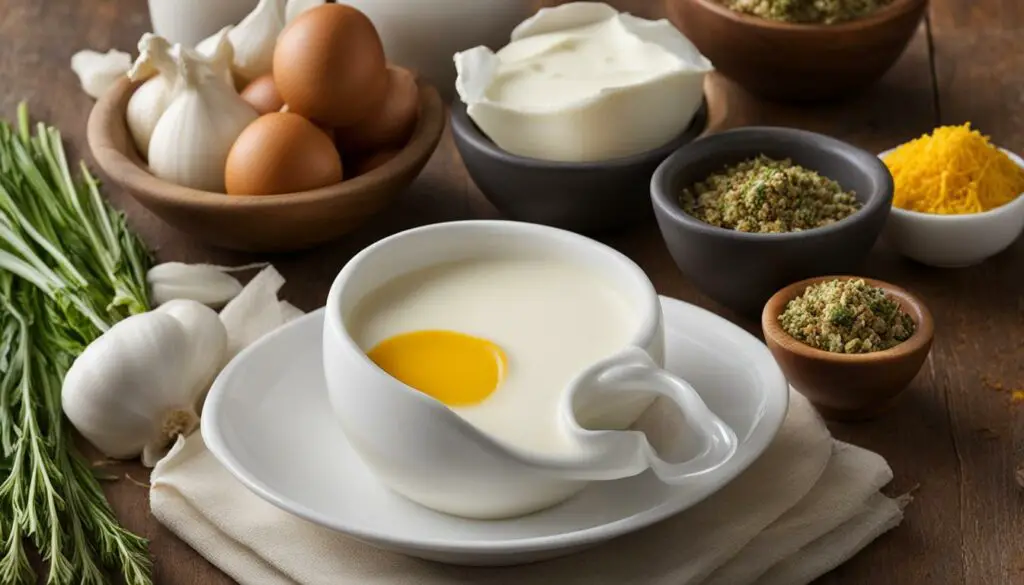
Sour cream can be a great last-minute substitute for milk in recipes. It adds moisture and a neutral flavor to the dish, making it an excellent option for baking. To replace milk with sour cream, use a one-to-one substitution. The creamy texture of sour cream helps maintain the desired moisture in your baked goods while providing a subtle tanginess that adds depth to the flavor profile.
If you’re looking to enhance the richness of your baked treats, sour cream is an ideal choice. It imparts a delightful creamy texture and a slightly tangy taste that pairs well with a wide range of recipes, including cakes, muffins, and quick breads. Its high fat content contributes to a moist and tender crumb, ensuring your baked goods come out perfectly every time.
“Sour cream adds a wonderful richness and tanginess to baked goods. It helps keep them moist and adds another layer of flavor. It’s a versatile ingredient that can be easily substituted for milk in a variety of recipes.” – Amy Smith, Professional Baker
Incorporating sour cream as a milk substitute in your baking not only adds moisture and flavor but also provides a creamy and velvety texture to the final product. Whether you’re making a classic chocolate cake, a tangy lemon pound cake, or a fluffy cinnamon coffee cake, sour cream can elevate the overall taste and texture.
Yogurt: A Delicious Milk Replacement for Recipes
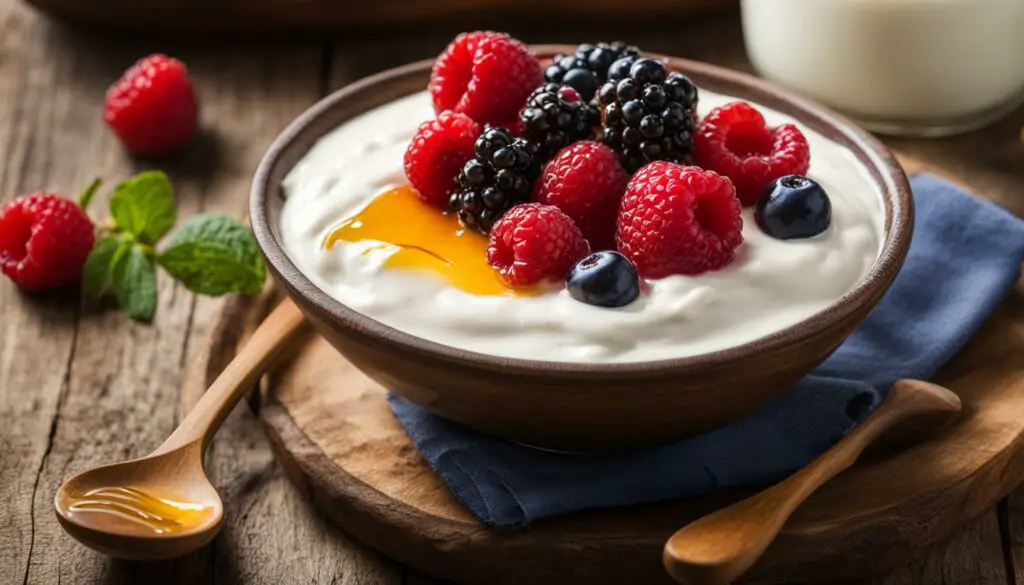
When you’re looking for a versatile and flavorful substitute for milk in your recipes, yogurt is an excellent choice. Not only does it add moisture to the dish, but it also provides a unique tang that can enhance the overall flavor profile. Plus, yogurt is packed with beneficial bacteria and nutrients, making it a healthy option.
Whether you’re baking a cake, making pancakes, or preparing a creamy sauce, yogurt can be used as a one-to-one replacement for milk. Simply measure an equal amount of yogurt and use it in place of the milk called for in the recipe. However, it’s important to note that when substituting yogurt for milk, it’s best to use plain, unsweetened yogurt to avoid any unwanted flavors or sweetness in the final dish.
To substitute yogurt for milk in a recipe:
- Measure the required amount of milk specified in the recipe.
- Replace the milk with an equal amount of plain, unsweetened yogurt.
- Proceed with the recipe as usual.
Yogurt not only provides a creamy consistency, but it also contributes to the overall moisture content of the dish. This makes it an ideal substitute for milk in recipes like muffins, quick breads, and smoothies.
However, it’s important to keep in mind that flavored yogurts may alter the taste of the final product. Stick to plain yogurt to maintain the intended flavors of your dish.
So the next time you find yourself without milk in your pantry, turn to yogurt as a delightful and nutritious milk replacement. Experiment with different recipes and enjoy the unique flavor and texture that yogurt brings to your dishes.
Evaporated Milk
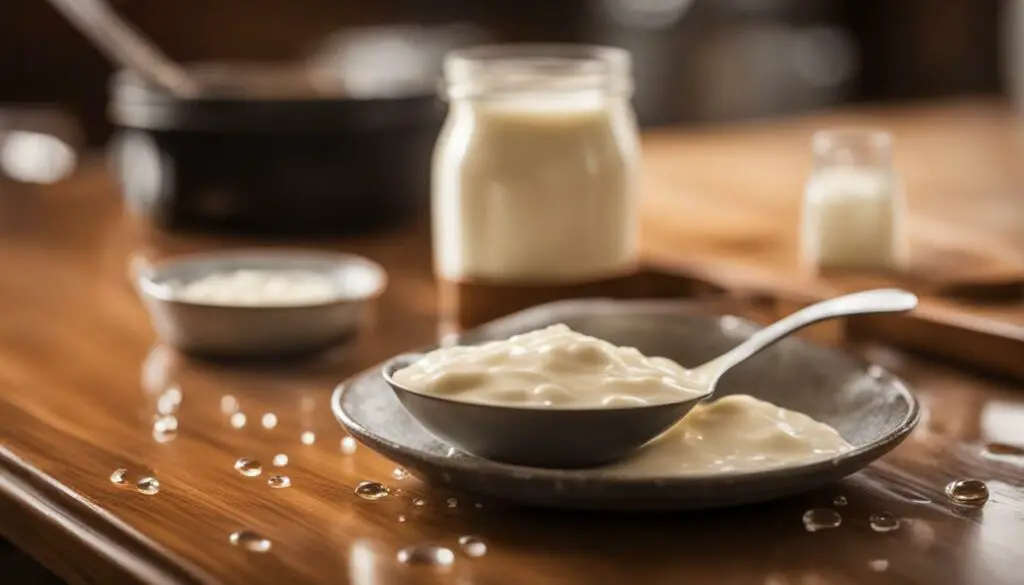
Evaporated milk, often found in the back of your pantry, can be used as a substitute for milk in baking and cooking. This canned milk provides a rich and creamy texture, adding flavor and moisture to your dish. When using evaporated milk as a substitute for milk, it’s important to know the proper ratio:
| Substitute | Quantity |
|---|---|
| Evaporated Milk | 1/2 cup |
| Water | 1/2 cup |
Simply mix half a cup of evaporated milk with half a cup of water to replace one cup of regular milk in your recipes. This combination will ensure the right consistency and flavor for your baked goods and other dishes.
With its long shelf life, evaporated milk is a convenient and versatile alternative to fresh milk. Whether you’re making a creamy dessert or a savory casserole, this canned milk is a reliable standby in your kitchen.
Canned Coconut Milk

Canned coconut milk is a versatile substitute for milk in recipes. Whether you’re looking to add a touch of tropical flavor or need a dairy-free option, canned coconut milk can be a great choice.
Before using canned coconut milk, make sure to give it a good shake to ensure that the contents are well mixed. This will help distribute the coconut cream evenly throughout the milk.
When substituting canned coconut milk for milk in recipes, use a one-to-one ratio. This means that if a recipe calls for 1 cup of milk, you should use 1 cup of canned coconut milk instead.
It’s important to note that canned coconut milk does add a hint of coconut flavor to the dish. So, if you’re not a fan of coconut or if the recipe doesn’t complement the coconut flavor, it might be best to choose a different substitute.
However, if you enjoy the taste of coconut, canned coconut milk can add a unique and delicious twist to your recipes. It pairs particularly well with dishes that have a tropical or Asian-inspired flavor profile.
Experiment with canned coconut milk in both sweet and savory recipes to explore its versatility. It can be used in everything from curries and soups to smoothies and desserts.
Water: A Limited Option as a Substitute for Milk
When you find yourself in a pinch and don’t have any of the above milk substitutes on hand, don’t worry! Water can serve as a last resort substitute for milk in recipes. While it may not provide the same richness and creaminess as milk, it can still get the job done.
When using water as a substitute for milk, it’s important to keep in mind that it can affect the overall texture and flavor of the final dish. To minimize the impact, it’s recommended to use water in small amounts, preferably a few tablespoons, rather than substituting it in a one-to-one ratio with milk.
Although water may seem like a simple and readily available option, its effectiveness as a milk substitute is limited. It lacks the fat and protein content that milk contributes to recipes, and it may not provide the same level of moisture or creaminess. However, in a pinch, it can still help you complete your recipe.
In the image above, the keyword “water” demonstrates its role as a substitute for milk.
Conclusion
In conclusion, there are numerous milk substitutes for cooking, providing alternatives to milk in recipes and catering to those with specific dietary needs. Whether you follow a dairy-free lifestyle or have lactose intolerance, there are plenty of options available to suit your preferences.
Experimenting with different dairy-free milk replacements can help you discover the perfect substitute that matches the taste and texture you desire for your recipes. From half and half to heavy cream, sour cream, yogurt, and evaporated milk, each alternative offers its unique advantages.
Additionally, plant-based alternatives like soy milk and almond milk provide excellent substitutes for milk in both sweet and savory recipes. While they may impart a slightly different flavor and richness, they are versatile options that can be used interchangeably with milk.
For those looking for a tropical twist, canned coconut milk is a delightful substitute that adds a hint of coconut flavor to your dishes. If you find yourself without any of these substitutes, you can always turn to water as a last resort, though it may affect the overall richness of the recipe.
Ultimately, the wide range of milk substitutes available ensures that you can enjoy your favorite recipes without compromising on taste or dietary requirements. So go ahead and get creative in the kitchen, exploring the various dairy-free alternatives to discover new and delicious possibilities!
FAQ
What can be used as a substitute for milk in recipes?
There are several dairy-free alternatives and substitutes for milk that can be used in cooking and baking.
Can half and half be used as a substitute for milk?
Yes, half and half can be used as a milk substitute in recipes. It is an equal mixture of whole milk and heavy cream.
How can heavy cream be used as a substitute for milk?
Heavy cream can be used as a milk substitute in recipes. However, it should be diluted with water using a one-to-one ratio of heavy cream to water.
What are some nondairy milk options that can replace milk in recipes?
Nondairy milks, such as soy milk and almond milk, are excellent alternatives to milk in recipes. They can be used as a one-to-one replacement for milk.
Can sour cream be used as a substitute for milk in recipes?
Yes, sour cream can be used as a substitute for milk in recipes. It adds moisture and a neutral flavor to the dish.
Is yogurt a good replacement for milk in recipes?
Yes, yogurt can be an excellent replacement for milk in recipes. Like sour cream, it adds moisture and flavor to the dish.
Can evaporated milk be used as a substitute for milk in recipes?
Yes, evaporated milk can be used as a substitute for milk in recipes. Mix half a cup of evaporated milk with half a cup of water to replace one cup of milk.
What about canned coconut milk as a substitute for milk in recipes?
Canned coconut milk can be used as a substitute for milk in recipes. Shake the can well before using and use a one-to-one substitution.
Can water be used as a substitute for milk in recipes?
Water can be used as a last resort substitute for milk in recipes. Try to use it in small amounts, preferably a few tablespoons, as it can affect the richness of the final product.
Are there any other alternatives to milk in recipes?
Yes, there are many options available as substitutes for milk in recipes. From half and half to nondairy milks, sour cream, yogurt, evaporated milk, canned coconut milk, and water, there are plenty of choices to suit different dietary needs and preferences.

